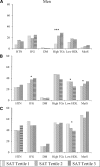Abdominal subcutaneous adipose tissue: a protective fat depot?
- PMID: 19244087
- PMCID: PMC2681034
- DOI: 10.2337/dc08-2280
Abdominal subcutaneous adipose tissue: a protective fat depot?
Abstract
Objective: Obesity is associated with increased metabolic and cardiovascular risk. The ectopic fat hypothesis suggests that subcutaneous fat may be protective, but this theory has yet to be fully explored.
Research design and methods: Participants from the Framingham Heart Study (n = 3,001, 48.5% women) were stratified by visceral adipose tissue (VAT) into sex-specific tertiles. Within these tertiles, age-adjusted abdominal subcutaneous adipose tissue (SAT) tertiles were examined in relation to cardiometabolic risk factors.
Results: In the lowest VAT tertile, risk factor prevalence was low, although systolic blood pressure in women and rates of high triglycerides, impaired fasting glucose, hypertension, and the metabolic syndrome in men increased with increasing SAT tertile (all P < 0.04). In contrast, in the top VAT tertile, lower triglycerides were observed in men with increasing SAT (64.4% high triglycerides in SAT tertile 1 vs. 52.7% in SAT tertile 3, P = 0.03). Similar observations were made for women, although results were not statistically significant (50.6% high triglycerides in SAT tertile 1 vs. 41.0% in tertile 3, P = 0.10). Results in the highest VAT tertile were notable for a lack of increase in the prevalence of low HDL in men and women and in rates of impaired fasting glucose in men with increasing subcutaneous fat, despite sizable differences in BMI across SAT tertiles (27.1 to 36.3 kg/m(2)[women]; 28.1 to 35.7 kg/m(2)[men]).
Conclusions: Although adiposity increases the absolute risk of metabolic and cardiovascular disease, abdominal subcutaneous fat is not associated with a linear increase in the prevalence of all risk factors among the obese, most notably, high triglycerides.
Figures


References
-
- Despres JP: The insulin resistance-dyslipidemic syndrome of visceral obesity: effect on patients' risk. Obes Res 1998; 6 ( Suppl. 1): 8S– 17S - PubMed
-
- Mokdad AH, Ford ES, Bowman BA, Dietz WH, Vinicor F, Bales VS, Marks JS: Prevalence of obesity, diabetes, and obesity-related health risk factors, 2001. JAMA 2003; 289: 76– 79 - PubMed
-
- Harris MM, Stevens J, Thomas N, Schreiner P, Folsom AR: Associations of fat distribution and obesity with hypertension in a bi-ethnic population: the ARIC study. Atherosclerosis Risk in Communities Study. Obes Res 2000; 8: 516– 524 - PubMed
-
- Lemieux I, Pascot A, Couillard C, Lamarche B, Tchernof A, Almeras N, Bergeron J, Gaudet D, Tremblay G, Prud'homme D, Nadeau A, Despres JP: Hypertriglyceridemic waist: A marker of the atherogenic metabolic triad (hyperinsulinemia; hyperapolipoprotein B; small, dense LDL) in men? Circulation 2000; 102: 179– 184 - PubMed
-
- Despres JP, Lemieux S, Lamarche B, Prud'homme D, Moorjani S, Brun LD, Gagne C, Lupien PJ: The insulin resistance-dyslipidemic syndrome: contribution of visceral obesity and therapeutic implications. Int J Obes Relat Metab Disord 1995; 19 ( Suppl. 1): S76– S86 - PubMed
Publication types
MeSH terms
Substances
Grants and funding
LinkOut - more resources
Full Text Sources
Other Literature Sources
Molecular Biology Databases
Research Materials

